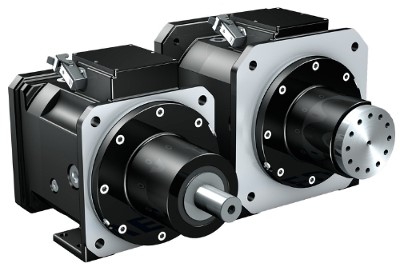
The PS two-speed gearbox from Stober Drives Inc. features two different options, from a direct drive to customer ratio choice. The 1:1 ratio direct drive can be used for high-speed cutting up to 10,000 rpm. The customer can choose from two ratios, 4:1 or 5.5:1, that are capable of turning at 7,000 rpm. This allows the customer to use a 1:1 ratio for low-torque, high-speed cuts and the 4:1 or 5.5:1 ratio for high-torque, lower-speed cuts.
"This gear box was designed for easy motor mounting," said Tyler Mattingly, applications engineer at Stober. "Simply slide the motor shaft into the input coupling, bolt the motor to the gearbox, and torque the coupling accordingly."
Stober offers two different output types: shafted and flanged, with three different versions of each utilizing a short, medium or long output. This allows Stober customize the product for customer applications, he added.
Three different bearing options for the output means even more customization options for an application. There is an option for a standard deep-groove ball bearing; an angular contact bearing; or cylindrical roller bearings, depending on the loads produced by a customer application. There are two different sizes to fit a variety of motors: the PS 25 and the PS 30. Utilizing these design features, this family of gearboxes is capable of up to 2,200 Nm worth of torque.
There are several advantages to STOBER PS2 Speed gearbox, said Mattingly. "The easy motor mounting means you can be up and running in minutes compared to hours," he said. "The option for a true neutral position isolates the input from the output. This means no back driving large spindle motors. During the 1:1 direct drive, we actually disengage the planet carrier for greater efficiency, so no back driving of the gearing is needed.
"Finally, we are capable of running in a motor-up orientation using only splash lubrication. This eliminates using an oil circulation system, which will save customers money."
Related Glossary Terms
- turning
turning
Workpiece is held in a chuck, mounted on a face plate or secured between centers and rotated while a cutting tool, normally a single-point tool, is fed into it along its periphery or across its end or face. Takes the form of straight turning (cutting along the periphery of the workpiece); taper turning (creating a taper); step turning (turning different-size diameters on the same work); chamfering (beveling an edge or shoulder); facing (cutting on an end); turning threads (usually external but can be internal); roughing (high-volume metal removal); and finishing (final light cuts). Performed on lathes, turning centers, chucking machines, automatic screw machines and similar machines.






